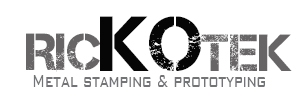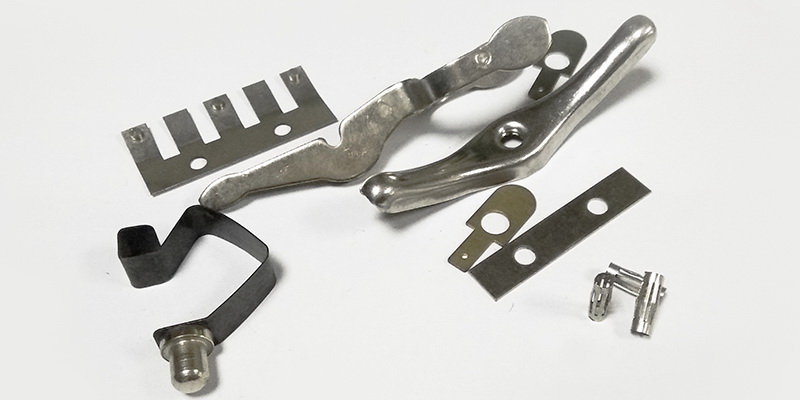While metal is a robust and durable material, metal stamping manufacturers have been shaping it into the parts using a hand-made process for many years. Over time, they had created different manufacturing methods for varying degrees of success.
For the mass manufacturing of similar parts made from metal, progressive die stamping has proven to be quite efficient, cost-effective, and productive.
Progressive Die Stamping Overview
It is a metalworking method that includes coining, bending, punching, and so forth to modify raw metal into specific shapes or designs.
The metal itself is unrolled through a progressive stamping die process, each of which creates a hole, shape, or bend that helps to create a finished product.
The method may involve one or more stamps to make a part or product from raw metal.
Normally, The progressive die stamping manufacturers would consider the unused part of the metals as scraps, either discard or use them for other purposes.
They change the tools to create different shapes of parts. That means setting up requires each tool to perform a specific function to get the final result.
Progressive Die Stamping Features
A person visiting a facility that performed progressive die manufacturing will see a series of machines that contain specific tools used to cut, bend, press, and shape raw metal materials.
The tools are aligning with a feeder track, which brings in the raw metal so the progressive die process can shape it.
Different types of metals may be used depending on the final product that is needed.
A technician usually stationed at the beginning of the track to oversee the feed of material. Depending on the number of stamps required, there may be additional technicians needed to ensure that the process is carried out correctly.
Once the stamping is completed, the final products are then inspected and finished for their specific needs.
How Progressive Die Stamping Works
This form of manufacturing is suitable for creating a high volume of identical parts from a raw metal material. Similar to an assembly line, the metal is fed in at one end with a series of die stations which press, cut, shape, or bend the metal at each step along the way.
At the other end, the finish metal part or product comes out, having gone through the metal forming service.
Here, the pieces are inspected to ensure quality, then polished, painted, or otherwise finished to meet the specific needs of their design.
Once completed, they are packaged and sent out from the facility.
For example, to create a metal plate to hold a door hinge, it must have a precise number of holes and shaped to fit the door.
Once it is finished, The QA Staff will inspect the plate and finish to protect the metal before shipping them from the facility.
Applications of Progressive Die Stamping
The number of applications is considerable when you account for the sheer number of metal parts that are used to create other products.
A good example is a beverage can lid which consists of the lid itself and the pull tab. Both the cover and pull separate progressive die stamping machines create tab before being put together in the final process.
The sheer number of applications is too many to mention, but it does include parts such as plates for car brake calipers that are bent into the proper shape.
Any standard product that uses metal stamping parts that can be cut, shaped, or pressed for a specific purpose is likely the result of progressive die manufacturing.
Pros
There are notable advantages of progressive die stamping in the continuous stamping process. It is especially true for companies that need a plentiful supply of metal parts for a particular product.
- Fast: Creating more parts in a shorter time using a metal stamping service
- Easy Setup: Far quicker compared to traditional machining or fabrication methods
- Less Scrap Metal: Arguably the most cost-efficient and least wasteful manner
- Repeatable: A metal stamp manufacturer creates more products in less time
- Low Cost: Because of automation, precision, and repeatability, the costs are quite low
You can create longer runs and more geometrics with this singular process compared to other methods of manufacturing.
One tool lets you create a wide variety of shapes, holes, bends, and folds time and time. Because the process can be repeated quickly, it is quite efficient in terms of manufacturing.
For the creation of most metal parts, it is difficult to find another method that beats progressive die stamping for its efficiency, repeatability, and precision.
Cons
Despite all the advantages, this process has a few issues.
For extremely detailed parts, especially those that must be accurate to a high degree, stamping is not the preferred method.
It is because the depth of the stamping may vary each time slightly, so some of the products may not be useful Because they are too inaccurate for high-precision parts.
Other issues with this form of stamping include the following;
- More uncooked material in the components compared to transfer squeezing
- Requires more expensive tools for progressive die work
- Poorly suited for short runs
This form of metal stamping service is suitable for a high number of runs for common parts. It is not ideal for short runs of more precision parts.
Therefore, the upfront cost of tooling requirements tends to become less over the production run. The shorter the run is, the more expensive the process.
Conclusion
For the creation of metal parts or products, especially those in high numbers, progressive die stamping is arguably the best method. Once it is set up, the metal stamp companies can create part after part after part through the progressive die system.
That is why for major manufacturers, the metal stamping service is easily the best, most cost-efficient, and most productive form of creating parts or products from metal.

